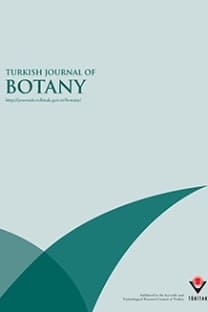Ranking of 11 coastal halophytes from salt marshes in northwest Turkey according their salt tolerance
Key words: Coastal ecophysiology, salt marsh, halophytes, salt tolerance
Ranking of 11 coastal halophytes from salt marshes in northwest Turkey according their salt tolerance
Key words: Coastal ecophysiology, salt marsh, halophytes, salt tolerance,
___
- Aronson JA (1989). HALOPH, a Data Base of Salt Tolerant Plants of the World. Tucson, AZ, USA: Office of Arid Land Studies, University of Arizona.
- Eshel A (1985). Effects of NaCl and KCl on growth and ionic composition of the halophytic C4 succulent chenopods Salsola kali, Suaeda monoica, and Suaeda aegyptiaca. Austr J Plant Physiol 12: 319–328.
- Flowers TJ, Colmer TD (2008). Salinity tolerance in halophytes. New Phytol 179: 945–963.
- Flowers TJ, Flowers SA, Greenway H (1986). Effects of sodium chloride on tobacco plants. Plant Cell Environ 28: 98–121.
- Flowers TJ, Troke PF, Yeo AR (1977). The mechanism of salt tolerance in halophytes. Annu Rev Plant Phys 28: 89–121.
- Garthwaite AJ, von Bothmer R, Colmer TD (2005). Salt tolerance in wild Hordeum species is associated with restricted entry of Na + and Cl into the shoots. J Exp Bot 56: 2365–2378.
- Hameed M, Nawaz T, Ashraf M, Naz N, Batool R, Ahmad BSMA, Riaz A (2013). Physioanatomical adaptations in response to salt stress in Sporobolus arabicus from the Salt Range, Pakistan. Turk J Bot 37: 715–724.
- Harrouni MC, Daoud S, Koyro HW (2003). Effects of seawater irrigation on biomass production and ion composition of seven halophytic species in Morocco. In: Lieth M, Mochtchenko M, editors. Tasks for Vegetation Cash Crop Halophytes. Dordrecht: Kluwer, pp. 59–70.
- Liangpeng Y, Jian M, Yan L (2007). Soil salt and nutrient concentration in the rhizosphere of desert halophytes. Acta Ecol Sin 27: 3565–3571.
- Lieth U, Menzel U (1999). Halophyte Database Vers. 2. In: Lieth H, Moschenko M, Lohmann M, Koyro HW, Hamdy A, editors. Halophytes Uses in Different Climates, Ecological and Ecophysiological Studies, Leiden, the Netherlands: Backhuys Publishers, pp. 159–258.
- Maas EV, Hoffman GJ (1977). Crop salt tolerance current assessment. J Irrig Drain 103: 115–134.
- Marschner H (1993). Mineral Nutrition of Higher Plants. 2nd ed. London: Academic Press.
- Munns R, Tester M (2008). Mechanisms of salinity tolerance. Annu Rev Plant Biol 59: 651–681.
- Özcan H, Akbulak C, Kelkit A, Tosunoğlu M, Uysal İ (2009). Ecotourism potential and management of Kavak Delta (Northwest Turkey). J Coastal Res 25: 781–787.
- Pujol JA, Calvo JF, Ramirez-Diaz L (2001). Seed germination, growth, and osmotic adjustment in response to NaCl in a rare succulent halophyte from southeastern Spain. Wetlands 21: 256–264.
- Richards LA, editor (1954). Diagnosis and Improvement of Saline and Alkali Soils (Handbook 60). Washington, DC: US Department of Agriculture.
- Rozema J, Bijwaard P, Prast G, Broekman R (1985). Ecophysiological adaptations of coastal halophytes from foredunes and salt marshes. Vegetatio 62: 499–521.
- Schofield RV, Kirkby MJ (2003). Application of salinization indicators and initial development of potential global soil salinization scenario under climatic change. Global Biogeochem Cy 17: 1078.
- Sekmen Esen AH, Özgür R, Uzilday B, Tanyolaç ZÖ, Dinç A (2012). The response of the xerophytic plant Gypsophila aucheri to salt and drought stresses: the role of the antioxidant defence system. Turk J Bot 36: 697–706.
- Tipirdamaz R, Gagneul D, Duhazé C, Aϊnouche A, Monnier C, Özkum D, Larher F (2006). Clustering of halophytes from an inland salt marsh in Turkey according to their ability to accumulate sodium and nitrogenous osmolytes. Environ Exp Botany 57: 139–153.
- Yasseen BT, Abu-Al-Basal MA (2008). Ecophysiological of Limonium axillare and Avicennia marina from the coastline of Arabian Gulf-Qatar. J Coastal Conservat 12: 35–42.
- ISSN: 1300-008X
- Yayın Aralığı: 6
- Yayıncı: TÜBİTAK
Pollenmorphology of Hymenosphace and Aethiopis sections of the genus(Lamiaceae) in Turkey Salvia
Musa DOĞAN, Ahmet KAHRAMAN, Birol BAŞER, Hülya ÖZLER, Ahter FİŞNE YAVRU, Sevil PEHLİVAN, Ferhat CELEP, Safi BAGHERPOUR
Wu JIANG, Billur Barshan ÖZAKTAŞ, Nitin MANTRI, Zhengming TAO, Hongfei LU
A new species and 2 new records from Turkey
Nivart Taşci MARGOZ, İbrahim Sırrı YÜZBAŞIOĞLU, Zeynep ÇELEN, Tuna EKİM, Ayşe Neşe BİLGİN
Pollen morphology of Hymenosphace and Aethiopis sections of the genus Salvia (Lamiaceae) in Turkey
Hülya ÖZLER, Sevil PEHLİVAN, Ferhat CELEP, Musa DOĞAN, Ahmet KAHRAMAN
Euglenozoa occurring in Adzopé Reservoir, Côte D’Ivoire
Blé Alexis Tardy KOUASSI, Kouhété Philippe DA, Allassane OUATTARA
Nadeesha Lewke BANDARA, Alessio PAPINI, Stefano MOSTI, Terence BROWN, Lydia Mary Josephine SMITH
Rafflesia sharifah-hapsahiae (Rafflesiaceae), a new species from Peninsular Malaysia
Jumaat Haji ADAM, Rahmah MOHAMED, Mohd Afiq Aizat JUHARI
Euglenozoa occurring in Adzopé Reservoir, Côte D’Ivoire
Blé Alexis Tardy KOUASSI, Allassane OUATTARA, Kouhété Philippe DA
Two new species of Cirsium (Asteraceae) and notes on allies from Turkey
